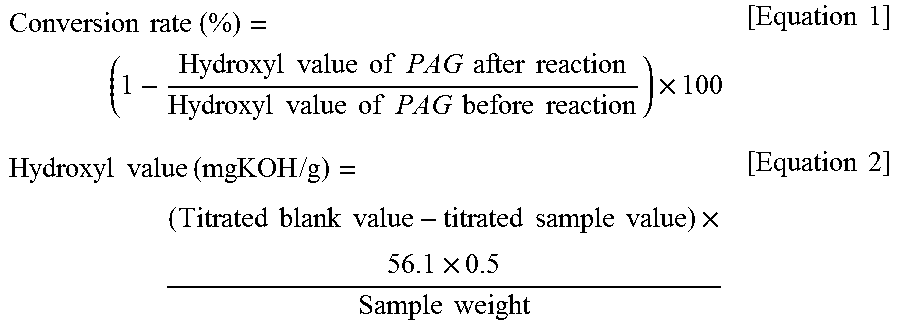Catalyst for alkylation of polyalkylene glucol and alkylation method using the same
- Summary
- Abstract
- Description
- Claims
- Application Information
AI Technical Summary
Benefits of technology
Problems solved by technology
Method used
Image
Examples
preparation example 2
[0082]156 g of Al(NO3)39H2O was added to 600 ml of distilled water and stirred, thus preparing a first alumina precursor aqueous solution, after which 28% aqueous ammonia was added to the first alumina precursor aqueous solution and stirred such that the pH of the first alumina precursor aqueous solution was 10.0, thus forming aluminium hydroxide. An aluminium hydroxide cake having the precipitated aluminium hydroxide was sufficiently washed with distilled water and isopropyl alcohol, and was then filtered using a filter press. The filtered aluminium hydroxide was dried at 110° C. for 24 hr, and was then calcined at 650° C. for 24 hr, thereby yielding a catalyst for alkylating polyalkylene glycol.
example 1
[0086]A cylindrical continuous-type reactor having a diameter of 1 inch, a height of 30 cm and a volume of 200 cm3 was packed with 100 cm3 of the catalyst of Preparation Example 1, and glass balls were placed on the top and bottom of the packed catalyst so as to prevent the packed catalyst from escaping to the outside. The cylindrical continuous-type reactor was provided in a cylindrical electrical furnace equipped with a temperature controller, after which the cylindrical continuous-type reactor was heated to 145° C. and maintained at this temperature, and polyalkylene glycol (PAG P-65, NH Chemical) having a viscosity (40° C.) of 65 cSt and a weight average molecular weight of 1,300 g / mol and dimethyl carbonate (KPX Green) were passed through the catalyst bed for 72 hr in the amounts and at the velocities shown in Table 1 below, and were thus allowed to react. The resulting product was separated from unreacted dimethyl carbonate, methanol, and carbon dioxide using a separator at 12...
examples 2 to 8
[0087]The reaction was carried out in the same manner as in Example 1, using individual catalysts under the reaction conditions shown in Table 1 below.
PUM
| Property | Measurement | Unit |
|---|---|---|
| Temperature | aaaaa | aaaaa |
| Temperature | aaaaa | aaaaa |
| Temperature | aaaaa | aaaaa |
Abstract
Description
Claims
Application Information
 Login to View More
Login to View More - R&D
- Intellectual Property
- Life Sciences
- Materials
- Tech Scout
- Unparalleled Data Quality
- Higher Quality Content
- 60% Fewer Hallucinations
Browse by: Latest US Patents, China's latest patents, Technical Efficacy Thesaurus, Application Domain, Technology Topic, Popular Technical Reports.
© 2025 PatSnap. All rights reserved.Legal|Privacy policy|Modern Slavery Act Transparency Statement|Sitemap|About US| Contact US: help@patsnap.com



